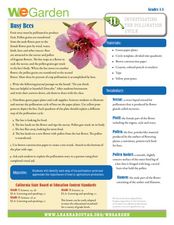Curated OER
Bees
Students design an experiment. In this bees lesson, students research pollination and work collaboratively to discover how bees aid in pollination. Students use tomato plants and create experimental designs. Lesson adaptations and...
Curated OER
Little Bees, Big Potential
After reading an article on the alfalfa leafcutting bee, learners chart its characteristics alongside those of the honeybee. Then they draw the leafcutter lifecycle. The article provides fascinating reading when studying the role of...
Curated OER
Busy Bees
Students explore the pollination cycle. In this pollination instructional activity, students investigate the process of pollination. Students illustrate the pollination cycle of bees on paper plates.
Rural Science Education Program
Bees and Flowers – Partners in Pollination
Why are bees so important? After several activities where kids investigate the form and function of flowers, they learn about the different types of bees and label them. They then examine pollen under a microscope and decide which bees...
Curated OER
Buzzing Bee's Wardrobe
Young scholars investigate the anatomy of honeybees. In this anatomy lesson, students research the physical characteristics of bees and discover what they do. Young scholars create a model of a honeybee showing the correct anatomy.
Oklahoma Ag in The Classroom
Bee Smart Bee Happy
Here is a wonderfully designed lesson on bees and pollination designed for early elementary learners. After a class discussion on bees, pupils pretend to be a bee by picking up nectar off of "flowers" in the class. The flowers are...
Curated OER
Bats, Bees, Birds, and Blossoms
Youngsters use a paper bee to pollinate two paper flowers. They use hole-punch dots as pollen. Older learners dissect flowers and name the structures involved in pollination. The handouts mentioned in the lesson plan are not included, so...
Curated OER
Why Are Bees Important?
Learners identify and analyze pollination and how bees play an important part in the life cycle of flowering plants. They also identify the process of plant pollination and how bees play an important part in the life cycle of flowering...
Desert Discoveries
What's the Buzz on Native Bees?
Young biologists describe the different types of bees that are native to the Sonoran Desert. They look at the nesting and feeding requirements of the insects, and study how they are able to pollinate many plants found in the environment....
Curated OER
Honeybee
Students investigate honeybees and the importance of honeybees to humans. They identify the various parts of a bee's body using velcro parts, role-play a hive, and answer review questions.
Curated OER
Too Bee Or Not To Bee
Students recognize that bees are important in the reproduction of plants and to the survival of animals. In this bee instructional activity, students become familiar with the parts of bees and how those adaptations help them pollinate...
Curated OER
What Bees Eat
Students study plant and animal interdependence by studying bees and pollination. In this interdependence lesson, students discuss flower parts and dissect it to show its reproductive parts. Students then use tissue and pipe cleaners to...
Curated OER
Pollen & Pollination
Students identify the different ways things are pollinated and how to manage pollen. In this pollination lesson students complete an experiment on how moths pollinate flowers.
Curated OER
Bee and Wasp Identification
Students study the differences between honey bee, bumble bee, paper wasp, and yellow jackets. In this insect classification instructional activity, students study posters of various bees and wasps. Students read the story Holly Honey Bee...
Curated OER
Getting a Handle on Your Bee
Students observe dried bees, carefully glue them to toothpicks, and use them for cross pollinating their Brassica plants. They also describe reasons why two similar investigations can produce different results. Finally, students...
Curated OER
The Life Of Bees
Students explore the matriarchal structure of a bee colony. They participate in various activities to identify the structure of a bee colony and the roles of each type of bee plays in the colony. Vocabulary and a worksheet with answer...
Curated OER
How Busy Are Bees?
Students research the jobs of bees. In this timeline lesson, students map out each of the six different jobs a worker bee does in its lifetime. They create a timeline and then retell the job descriptions.
Curated OER
The Disappearing Honeybees: Tracking Honeybee Decline
Middle schoolers practice graphing and other math skills to track number of honeybee colonies present in United States since 1978, discuss major crops that are dependent on insect pollinators, and examine reasons for decline of United...
Curated OER
The Sweet Connection
Students use maps to find what crops are dominant in areas where honey bees are raised and discuss possible correlations. They mark the top ten honey- producing states on a US map.
Curated OER
Buzzy, Buzzy Bee
Learners simulate honeybees pollinating flowers. In this pollination lesson, students role-play the process of pollination over the course of several seasons. Learners graph results and share their graphs with the class.
Towson University
Looking Backwards, Looking Forward
How do scientists know what Earth's climate was like millions of years ago? Young environmental scholars discover how researchers used proxy data to determine the conditions present before written record. Grouped pupils gain experience...
Curated OER
Honey Bees!
Students research and complete two assignments about honeybees. Students draw and color a picture of a flower with a honeybee inside of it. Students write a letter to the executives at Ridit Pest Control persuading them to stop the...
Curated OER
What Bees Eat
Students consider the concept that plants and animals are dependent on one another and role-play the interaction between bees and flowers. They identify crops that are dependent on pollination by bees.
Curated OER
Flower Powder
Students collect and observe pollen. In this plant reproduction biology lesson, students use pollen boards to collect pollen from flowers, then match it with the correct paper flowers. Students move artificial bees from flower to flower...

























